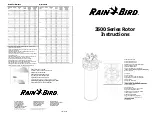
Chapter 4. EQ-77X Setup
EQ-77X LDLS® Operation Manual
18
of
32
Chapter 4. EQ-77X Setup
4.1 Connections
Installation of the
EQ-77X consists of connecting electrical, cooling fluid, and purge gas supplies, as well as connecting
the lamp head module to the user’s equipment. Read
first before making any connections.
4.1.1 Electrical Power
The
EQ-77X
requires 100 – 240 V~, 50/60 Hz input voltage. Power consumption is 350 W maximum during normal
operation. Some OEM versions have higher current requirements.
4.1.2 Purge Gas
It is strongly recommended that nitrogen purge gas is used during operation of the EQ-77X
system. For optimal
product performance, nitrogen gas purging of the
EQ-77X
system is required during operation. If nitrogen purge gas is
not used, shorter lifetime and faster output degradation (especially in the ultraviolet wavelength range) is expected.
Product use without nitrogen purge gas will result in the buildup of ozone (from atmospheric oxygen) and attenuate
the light output in the 220-280 nm band, as well as below 200 nm in the presence ofatmospheric oxygen and water
vapor.
The purge port fitting is a push-to-connect type, sized for 4mm O.D. tubing.
Clean and dry nitrogen from either a Dewar or research-grade N2 bottle is recommended. Do not use any other purge
gas. Grade 4.8 or higher gas purity is recommended to maintain cleanliness of the optics, and gas should be filtered to
<5um. Supply pressure should be 20 psig (0.14 MPa). With a 20 psig inlet pressure, the EQ-77X
will consume
approximately 0.5 slm of flow.
4.1.3 Cooling Fluid
Cooling fluid fittings are 1/4-inch Swagelok female. Coolant flow rate of at least 1 liter/minute is required. Inlet
temperature should be between 18°C and 30°C.
Care must be taken when making connections to avoid damage to the fittings and tubing. Two wrenches must always
be used – one to hold the fitting body, and another to tighten the nut. See the figure
below for more
details.
To make the connection: first insert tubing into the fitting and tighten the nut finger tight. Then tighten the nut 1-1/4
turns from the finger-tight position, using two wrenches as shown.















































